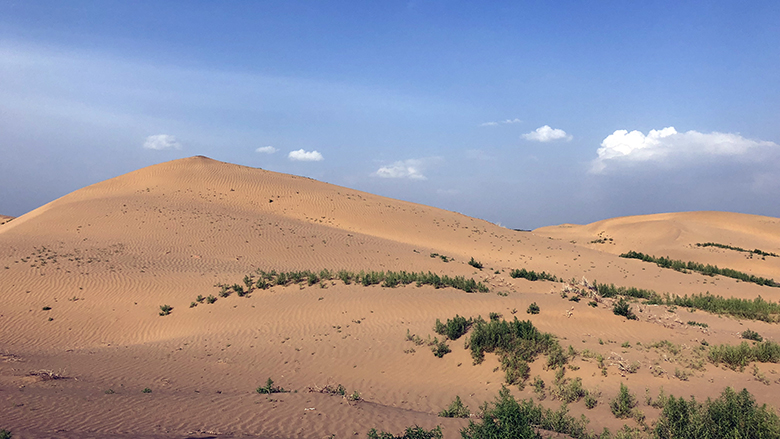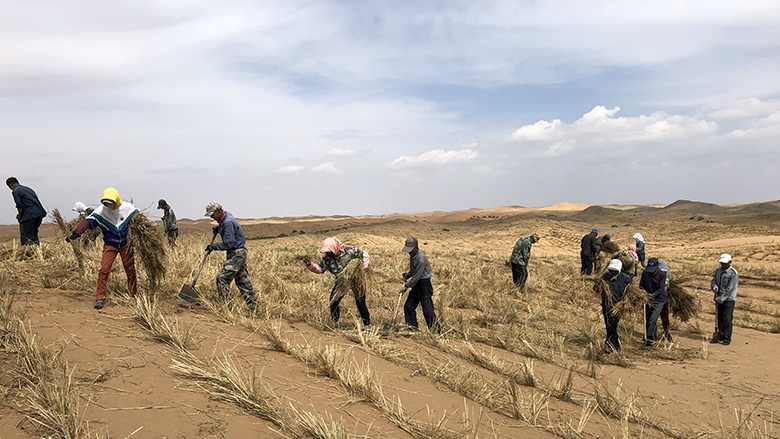Challenge
China has been severely impacted by desertification, with over one-quarter of the country affected by this challenge. While desertification has both natural causes, such as shifts in climate, and human-driven causes, such as the clearing of vegetation, overgrazing, and the depletion of water resources, challenges created by humans are the most prevalent in China, with change threatening to exacerbate these problems.
In the Ningxia Hui Autonomous Region in northwest China, desert encroachment is a historical challenge, with overgrazing of vegetation causing many dunes to lose their protective vegetation cover and become mobile. By 2010, over 57 percent of Ningxia’s territory (2.97 million hectares) was affected by desertification, with more than 3 million people suffering the consequences - including sandstorms and dust pollution.
Desertification was also undermining agricultural output in the region, reducing soil fertility and threatening to bury fields and infrastructure in sand. The impacts were being felt well beyond Ningxia. Sediment from degraded land was flowing into the Yellow River, reducing water quality and increasing the risk of flooding downstream, while sandstorms affected increasingly larger areas of northern China.

(Sand dunes become mobile due to loss of vegetation cover. Photo: © Li Li/World Bank)
Approach
The Government of Ningxia requested World Bank support in 2010 to help improve the performance of desertification control and remediation efforts, which led to the Ningxia Desertification Control and Ecological Protection Project.
The project helped alleviate financing constraints faced by some of the counties in Ningxia which were being most severely affected by desertification - allowing for scaling up of pilot activities. Moreover, the project promoted technical advances by adopting improved restoration methods that introduced diversified indigenous grasses and shrubs to better control desertification, while simultaneously contributing to ecosystem resilience.
While such investment financing only addressed China’s desertification problem in selected areas, World Bank support generated other tangible impacts in other areas and influenced subsequent government projects through its innovation and demonstration effects.
Results
The project was implemented from 2012 to early 2020. Through vegetation restoration and sand stabilization measures, the project protected infrastructure and farmland in selected areas of Ningxia and yielded broader impacts - such as reduced silt in the Yellow River and fewer sandstorms affecting northern areas of China. Moreover, the increased diversification of vegetation mainstreamed biodiversity at the landscape level, promoting a reversal of degradation processes and contributing to improved ecosystem resilience. More specific project results by the end of the project include:
- 32,351 hectares of degraded land were improved through vegetation restoration and natural regeneration promotion.
- Land degradation was reversed in the project area demonstrated by an increase of vegetation cover by 28 percentage points, greater vegetation diversity and improved soil quality with biocrust developed (a thin layer of lichens, cyanobacteria, arid land mosses and microorganisms that help to retain water and nutrients).
- Training was provided to officials, project staff and farmers to improve land management capacity and scale up the project's newly developed techniques. Consequently, the seeding survival rate of re-vegetation activities exceeded 70 percent, at least 5 percentage points higher than before the project.
- 8,158 people were employed planting, tending and patrolling forests, with per-capita income increasing by about $2,300 a year from these wages. Longer-term benefits are expected for the 3,809 farmers who participated in the multifunction shrub plantation pilot in Zhongwei, which established 2,134 hectares of Chinese dwarf cherry and wolfberry for commercial sale. Average per-capita income from these activities was $1,700 - US$2,400 per year, depending on the crops, with yields and incomes expected to grow as the plantation matures. In addition, more than 4,700 herders affected by grazing enclosures received farm machinery and other assets to support a livelihood transition.
- Total carbon sequestration at project closing was estimated to exceed 88,000 tons and is expected to grow substantially as vegetation matures.
- Wind erosion was reduced, due to increased vegetation cover, with an estimated 3,396 tons of soil conserved per year.
- 2,455 hectares of shelterbelt plantations were established, providing protection for 3,800 hectares of farmland and 514 kilometers of road and rail infrastructure.
- The Yellow River received protection through reduced silt and sediment, saving on removal costs estimated at $200 million. The number of days with windblown sand decreased from 12.4 to 9.1 per year, on average, across the three largest project counties.

